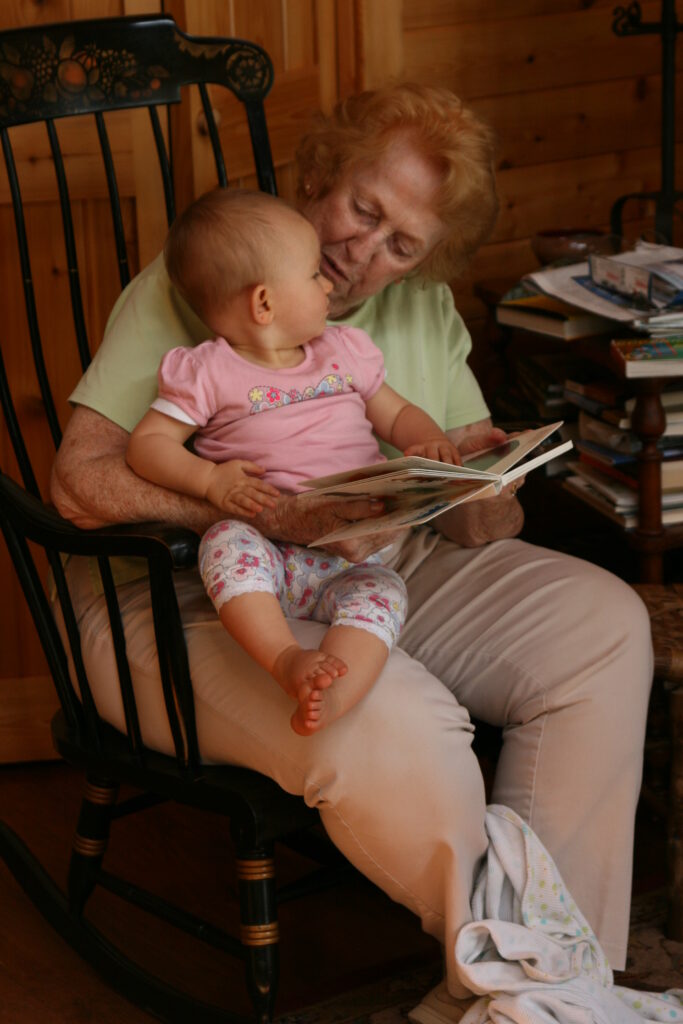Editor’s Note: This month, our “Honey for a Child’s Heart Read-Along” partners are thinking about Chapters 3, 13, and 14. The latter two chapters are about picture books, as is fitting for Picture Book Month. Chapter 3 asks what makes a good book, a question Gladys Hunt explored further in today’s blog post.

What Makes a Really Good Book?
Originally published on the Tumblon website, September 16, 2009
“The story is only as good as its first line,” the instructor told his writing class. “If young readers don’t like the first line, they will never look at the second one. We live in a sound bite age.” The instructor was Richard Peck (A Long Way From Chicago; A Year Down Yonder) and he was having a hard time convincing his students. He wrote a first line he said was just crying out for a novel to go with it: “If your teacher has to die, August isn’t a bad time of year for it.” The novel became The Teacher’s Funeral: A Comedy in Three Parts.
Publishers Weekly gives an annual award for the best opening line in children’s books. Like this one from How I Became a Pirate: “Pirates have green teeth—when they have any at all.” The next year the winner was Peck’s line about teachers dying in August.
But is that what makes a good book? It may be a factor because it simply says that the story has to capture its audience. The reader needs an easy entrance. However, it takes a good deal more than a good first line to make a story that is memorable and stays in your heart.
Most editors are reluctant to be pinned down when asked this question. As our society becomes more pluralistic and relativistic, they don’t want to get backed into a corner if the answer doesn’t meet all the items on the issues agenda. What is good is likely to vary with the standards and character of the decider. And there is always the possibility of being wrong in one’s judgment of a book, especially at the time of first reading it. But good books have a way of overcoming all that. No one had more official authority in children’s book decisions than Ann Carroll Moore, who for thirty-five years headed the children’s library services for the New York Public Library, and she disapproved of Charlotte’s Web. Children didn’t agree, and the popularity and quality of that book now embarrasses those who refused to give it a Newbery Medal the year it was published. Ruth Hill Viguers questioned the fitness of Harriet the Spy, but the book went on to popularity. And what of Dav Pilkey’s Adventures of Captain Underpants with its dorky humor? Does that go on anyone’s keep-forever book list? Or does that become a product that produces giggles?
One thing most editors agree is that when they pick up a really good book it is what one of them called, “A zipless read.” The reader is not conscious of having to stop and figure anything out or to monitor herself while reading. She just reads it. It captures the evaluator, who stops evaluating and reads, caught up in the story. This is not conclusive in making a decision, but it is a spontaneous reaction that the editor learns to respect. So there is a spontaneous response and a considered response.
Obvious questions are asked about the book: are the characters real? Do you care about them? Is the dialog natural-sounding? Do the characters make the plot happen or does the plot force action on the characters? Is it believable? Does the “truth” in the book arise naturally from the character’s actions or rather contrived circumstances that make them change? Is there depth in the story, so that subsequent readings will give new insights? The true value of a book is in the experience of the reader. A really worthwhile book makes a reader say, “Wow! This is a really good book!” And the story stays around and reverberates long after it is read.
Also at Redeemed Reader:
- See Gladys Hunt’s further thoughts on the subject in her post, “How to Know the Best Children’s Books.”
© Gladys M. Hunt 2008-10, reissued in 2022 with minor adjustments with permission of the Executor of the Literary Estate of Gladys M. Hunt (4194 Hilton SE, Lowell, MI 49331). Used by permission. All rights reserved.
Support our writers and help keep Redeemed Reader ad-free by joining the Redeemed Reader Fellowship.
Stay Up to Date!
Get the information you need to make wise choices about books for your children and teens.
Our weekly newsletter includes our latest reviews, related links from around the web, a featured book list, book trivia, and more. We never sell your information. You may unsubscribe at any time.
We'd love to hear from you!
Our comments are now limited to our members (both Silver and Golden Key). Members, you just need to log in with your normal log-in credentials!
Not a member yet? You can join the Silver Key ($2.99/month) for a free 2-week trial. Cancel at any time. Find out more about membership here.

